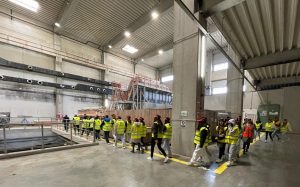ANIS Romania: In Paris, the signals regarding AI were clear. Is Romania on the receiving end?

Author: Corina Vasile, Executive Director, ANIS Romania
At the recent AI Summit in Paris, political and business leaders watched with bated breath the strategic directions drawn in the race for artificial intelligence. The United States and the European Union have clarified their positions, and the message is clear: AI will be the main engine of the economy of the future.
The US is accelerating through a strong private ecosystem, dominated by technology giants and supported by massive government support, deregulation initiatives and strategic financing. Efforts to consolidate American leadership in AI recently culminated in the Stargate project, a joint venture of up to $ 500 billion in AI infrastructure, announced since the early days of the Trump administration, with the participation of prominent leaders from the IT industry.
On the other side of the Atlantic, the EU wants safe, ethical AI and applied in essential industries, such as health, energy and industrial production. European Commission President Ursula von der Leyen has announced €200 billion in investments for AI Factories and AI Gigafactories, aimed at ensuring broad access to AI infrastructure for businesses and researchers. On the other hand, industry is raising increasingly strong alarm bells about the risks of excessive regulation, especially in the context of the development of the General Purpose Artificial Intelligence (GPAI) Code of Practice.
There are serious concerns that an overly restrictive regulatory framework, combined with complex and costly compliance requirements, could stifle innovation and put the EU at a global competitive disadvantage, in contrast to other regions that adopt more flexible and pro-innovation policies. China has stepped up its soft power pro-cooperation move, after a month earlier a new release by the Chinese-origin company DeepSeek demonstrated what it can do in AI with much less money than its American competitors. In this new technological reality, Romania urgently needs to decide where it stands.
As part of the European Union, we have the opportunity to integrate into European AI initiatives and access the necessary funds to become a relevant player. In the absence of a series of realistic actions, however, we risk remaining only IT service providers for other economies, without generating innovation and added value of our own. Romania adopted a National Strategy for Artificial Intelligence and an Action Plan last year, supported at a declarative level by a commitment to the adoption of technology at the societal and economic level, but progress is limited. Romania needs to make the leap from declarations of intent to the adoption of concrete measures to make the transition to a technology-based economy that capitalizes on the potential of AI – a clear implementation framework, adequate funding and collaboration mechanisms between the public, private and academic sectors.
Romania has a strong IT&C industry, which generated 22 billion euros in 2023 and contributes 14.16% to GDP (*through the effect of direct, indirect and induced contributions). We have a large number of well-trained specialists and a solid digital infrastructure, but these advantages may become irrelevant if we do not strategically invest in AI and accelerate innovation.
The figures show that Romania is generally not capitalizing on technology opportunities:
- only 0.46% of GDP is invested in research and development, compared to the EU average of 2%.
- 75% of IT companies have had innovation initiatives in the last three years, but only 5.7% have launched their own product in this period. • Romania ranks last in Europe in terms of innovation, according to the European Innovation Scoreboard.
- only 27% of SMEs adopt advanced digital technologies, below the EU average of 58%.
- 5G coverage is only 32.8%, compared to the EU average of 89.3%. These data demonstrate that Romania not only needs to catch up with the rest of Europe, but also make a rapid qualitative leap.
What can we do to become an AI hub in Europe? 1. Adopt a European AI innovation model
✅ Actively participate in the discussions on the European future of AI and align with EU initiatives, such as the AI Act, AI Factories and InvestAI, to harmonize the regulatory framework and facilitate the process of accessing European funds for AI.
✅ Increase investment in research and development to 1% of GDP by 2027, to reduce the gap with Western Europe.
✅ Introduce an IP Box regime and incentives for companies that develop intellectual property and capitalize on the potential of emerging technologies, such as AI. 2. Strengthen the workforce specialized in AI
✅ Integrate AI into university programs, to train specialists prepared for new technological requirements and implement programs that support the retention of specialists, respectively the attraction of international talents. ✅ financing training and professional reconversion programs (upskilling/reskilling) to encourage investments in employee skills development and AI adoption at the labor market level.
✅ developing AI R&D hubs, in partnership with universities and private companies, to support continuous training and technology transfer. 3. Accelerating the digitalization of the economy and administration
✅ promoting the adoption of AI in the private sector through grant schemes for SMEs and startups and incentives for investments in technology at the company level.
✅ adopting AI solutions for public administration, from digitizing services to combating bureaucracy.
✅ supporting public-private partnerships for the development of AI solutions in essential economic sectors and creating regulatory sandboxes that allow testing of new AI solutions in a controlled environment.
The Paris AI Summit was a clear signal: the EU is entering the new technological era more decisively, and Romania has the chance to be an active part of this transition. Investments in AI are no longer an option, but a strategic necessity. If we do not invest in AI now and do not integrate into European initiatives, we will not only lose development opportunities, but also become dependent on solutions created in other states. Romania can become a regional hub for AI, a pillar of the European digital economy, but this requires firm decisions, smart investments and a clear vision, aligned with the European Union’s digital strategy. It is no longer a question of “if”, but of “when and how” we assume this role.













